
Heart disease is a major cause of death, affecting over one-third of the world's population. In China, hundreds of thousands of people die of heart disease every year. If we can predict and diagnose heart disease in patients, we can reduce the number of deaths cause by heart diseases.
A promising method of screening heart diseases is through data mining. By extracting common physical examination indicators, we can build a reliable prediction model for each patient. This article illustrates how to build a heart disease prediction case through the Alibaba Cloud machine learning platform using real data.
Data Source: UCI open-source Heart Disease Data Set
The data set below contains the physical examination data of heart disease patients in an area in the United States, with 303 instances in total. The specific fields are as follows:
| Field | Meaning | Type | Description |
| age | Age | string | Age of the subject, in number. |
| age | Age | string | Age of the subject, in number. |
| cp | Chest pain types | string | The pain severity from high to low is: typical, atypical, non-anginal and asymptomatic. |
| trestbps | Blood pressure | string | Blood pressure value. |
| chol | Cholesterol | string | Cholesterol level. |
| fbs | Fasting blood sugar (FBS) | string | If FBS > 120 mg/dl, true, otherwise false. |
| restecg | Electrocardiographic results | string | Whether T wave exists. From mild to severe: norm, hyp. |
| thalach | Maximum heart rate | string | Maximum heart rate. |
| exang | Exercise induced angina | string | If the patient has angina, true; otherwise false. |
| oldpeak | ST depression induced by exercise relative to rest | string | Pressure of the ST segment. |
| slop | The slope of the peak exercise ST segment | string | The slope of the ST segment. Different degrees of down, flat or up. |
| ca | Number of major vessels colored by fluoroscopy | string | Number of major vessels colored by fluoroscopy. |
| thal | Defect categories | string | Categories of complications. From mild to severe: norm, fix, and rev. |
| status | Whether diseased | string | Whether diseased. Buff indicates healthy, and sick indicates diseased. |
The following diagram illustrates the data mining process.
Image 1:
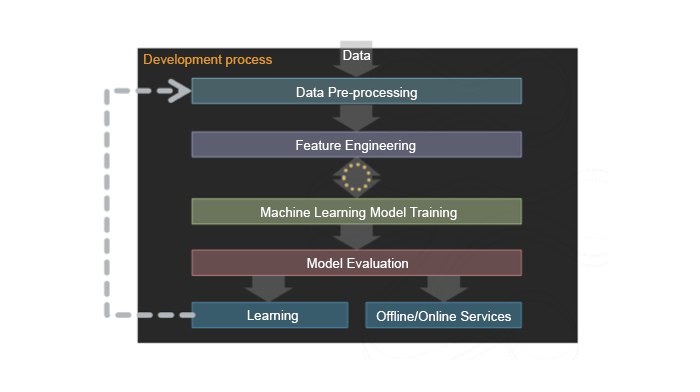
The diagram below illustrates the specific steps required to deploy the data mining process.
Image 2:
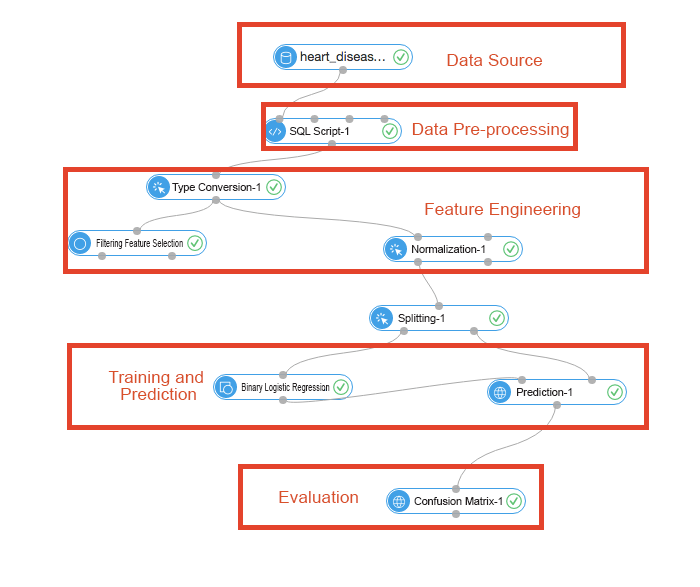
Data pre-processing, also called data cleansing, removes data anomalies through data de-noising, missing value insertion, and type conversion operations before the data is used in an algorithm. The input data for this experiment consists of 14 features and a target queue. In this algorithm, the possibility of a user suffering from a heart disease is predicted based on the user's physical indicators. Because this classification experiment adopts linear logistic regression, all input values are binary.
The table below represents the input data.
Image 3:
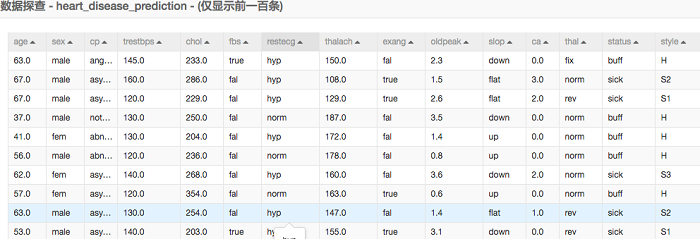
We can see that a most data are text descriptions. In the data pre-processing process, we need to map the character string into specific values.
SQL scripts implement the data pre-processing. For details, refer to SQL script-1 component.
select age,
(case sex when 'male' then 1 else 0 end) as sex,
(case cp when 'angina' then 0 when 'notang' then 1 else 2 end) as cp,
trestbps,
chol,
(case fbs when 'true' then 1 else 0 end) as fbs,
(case restecg when 'norm' then 0 when 'abn' then 1 else 2 end) as restecg,
thalach,
(case exang when 'true' then 1 else 0 end) as exang,
oldpeak,
(case slop when 'up' then 0 when 'flat' then 1 else 2 end) as slop,
ca,
(case thal when 'norm' then 0 when 'fix' then 1 else 2 end) as thal,
(case status when 'sick' then 1 else 0 end) as ifHealth
from ${t1}; Feature engineering includes feature derivation and scale variation. In this example, there are two components responsible for feature engineering: filtering feature selection and normalization.
Image 4:
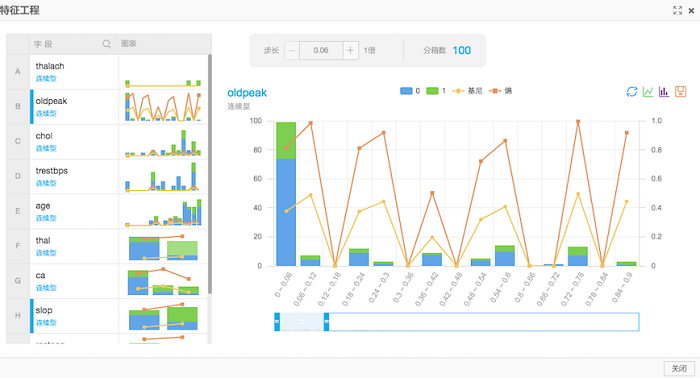
Image 5:
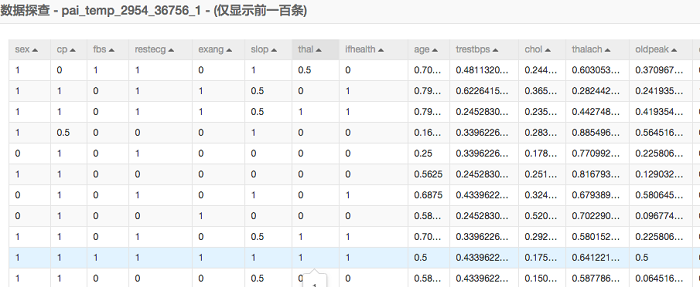
We can train our prediction model by analyzing existing data because we already know whether each patient has heart disease. This process is also known as supervision and learning. The trained model is then used to predict if users suffer from heart disease. The training and prediction process is described as follows:
Image 6:
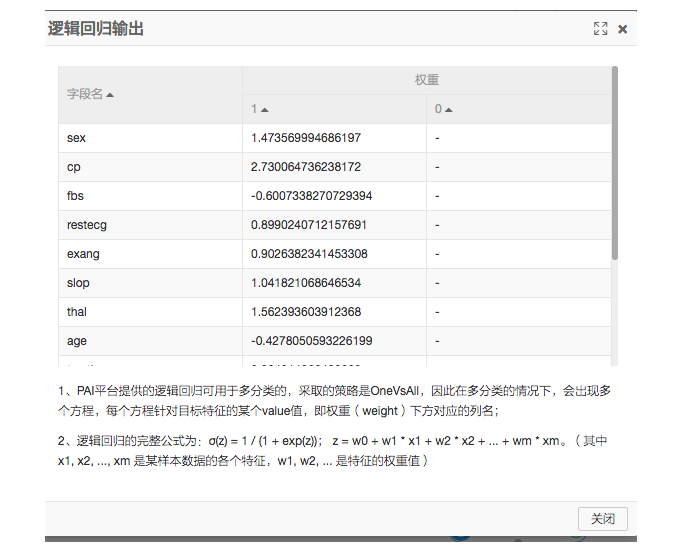
Image 7:

The prediction model can be further fine-tuned using feature engineering. We can adjust the weight of each feature to produce more accurate results. In our observations:
The image below shows the adjusted weights in our model based on feature engineering. A higher weight value indicates a stronger correlation to the outcome.
Image 8:
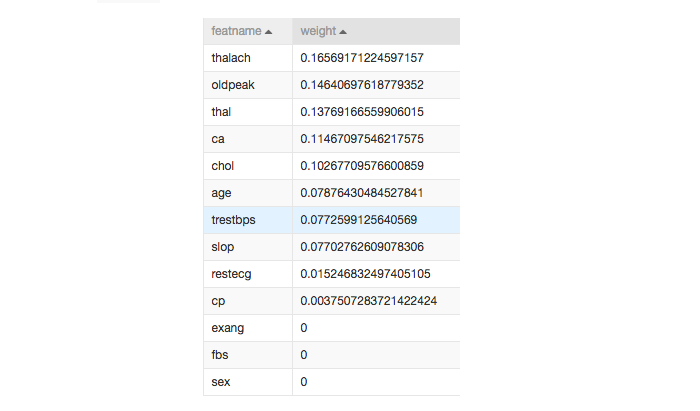
By using the weighted features provided above, we can achieve a heart disease prediction accuracy of greater than 80 percent. With further research, this model can be used to assist physicians in the prevention and treatment of heart disease.
With the prevalence of heart disease in the modern society, predicting such a disease would not only be a pioneering breakthrough but also be opening the floodgates to a variety of applications in predictive medicine.
Heterogeneous Computing: Dominated by GPU, FPGA, and ASIC Chips

2,593 posts | 790 followers
FollowGarvinLi - December 27, 2018
Alibaba Clouder - August 22, 2019
GarvinLi - January 18, 2019
Amy - October 8, 2022
Alibaba Cloud Community - June 16, 2022
Alibaba Clouder - March 27, 2019

2,593 posts | 790 followers
Follow Platform For AI
Platform For AI
A platform that provides enterprise-level data modeling services based on machine learning algorithms to quickly meet your needs for data-driven operations.
Learn More Epidemic Prediction Solution
Epidemic Prediction Solution
This technology can be used to predict the spread of COVID-19 and help decision makers evaluate the impact of various prevention and control measures on the development of the epidemic.
Learn More Function Compute
Function Compute
Alibaba Cloud Function Compute is a fully-managed event-driven compute service. It allows you to focus on writing and uploading code without the need to manage infrastructure such as servers.
Learn More Machine Translation
Machine Translation
Relying on Alibaba's leading natural language processing and deep learning technology.
Learn MoreMore Posts by Alibaba Clouder